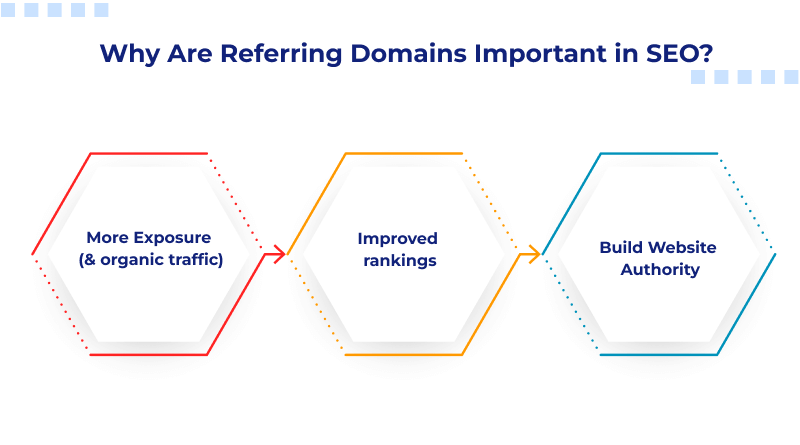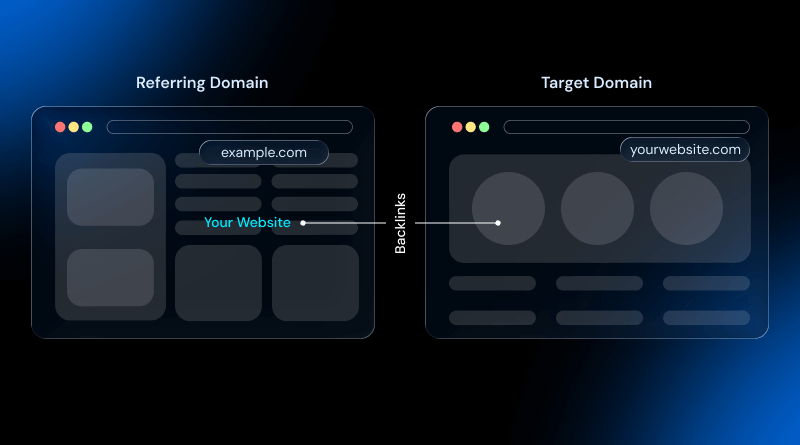Backlinks are part of SEO. We all know it! But not all backlinks are created equally. You need a strong referring domain. Now, what is the referring domain? Let’s share an example. If our web hosting website is linked with any random tech website, then the tech website is a referring domain to ours.
Picking any random website with a low DA or high spam score for backlinking is a black hat SEO practice. You can check these metrics on Moz. Regarding the referring domain, you should assess its strength before acquiring backlinks from it. This blog provides detailed information on what a referring domain is and why it is necessary.
Table Of Content
What Is a Domain Name?
A unique web address is called a domain name. For instance, in the URL: https://www.xyz.com, the xyz acts as a website’s identity. It acts like a physical address for a home or business.
A domain is made up of two main parts:
- Top-Level Domain (TLD): It is the part coming after the domain name, like .in, .com,.net, or country-specific ones like .in or .ca. Read more about it in our What Is a TLD blog.
- Second-Level Domain: This is the part that identifies the specific website, like Google or Wikipedia.
When you talk about a referring domain, you are specifically referring to the unique website address from which a link originates.
What is the Referring Domain?
A referring domain is an external website that links back to your website. Google prefers content or websites that have backlinks from strong domains. It increases organic traffic and provides your website with more brand exposure.
According to a Semrush study, the Rank No. 1 webpage has more than 200 referring domains on average. At the same time, the 10th position garners only 80 referring domains on average.
Difference Between Referring Domain and Backlinks
Backlinks and referring domains sound similar, but they aren’t. Understand the differences between the referring domain and backlinks.
- A backlink is a single hyperlink from your website to an external website.
- A referring domain is an external website that refers traffic to your website through its backlink.
Through off-page SEO methods like guest posting, brand mentions, or third-party platform posting, you can obtain hyperlink anchor texts. So, there are no specific restrictions on the number of backlinks you can generate. However, SEO experts suggest the homepage must have quality 40-50 backlinks.
Why Are Referring Domains Important in SEO?
Backlinking high-quality websites is a clear strategy to boost search engine ranking. But it depends on the position of the backlink, its relevance, and the anchor text.

1. More Exposure and Organic Traffic
More referring domains mean more exposure to your website. Your presentation power increases in front of a broader audience. Ultimately, it increases organic traffic to your website. The reason is simple. If your website gets 10 backlinks from 10 popular domains like Forbes, ET Times, and others, it reaches a higher number of people, obtaining more potential customers.
You can also get a few backlinks from one website, but the content’s reach is restricted to a few popular domains only. It will bring more people to your website.
2. Improved Rankings
Not just backlinks, but the number of referring domains also plays a pivotal role in search engine ranking positions. Having multiple referring domains on your website increases the chance of better rankings. Web crawlers or spider bots discover new pages, extracting all outbound links and assessing their anchor texts. During the process, it also fetches details like (do-follow or no-follow).
Search engines then use this information to understand how your site is being referenced across the web. The more high-quality referring domains you have, the faster your pages can be discovered, crawled, and indexed, ultimately boosting your site’s authority and visibility in search results.
“A diverse portfolio of referring domains can signal to search engines that your content is trusted. … According to the SEO software firm Ahrefs, 96.55% of web pages get no organic traffic from Google. One of the most common reasons Ahrefs cites for this is the lack of backlinks, especially from unique referring domains.”
— from Shopify
3. Build Website Authority
Your backlinks from unique domains are votes of confidence. It signals to search engines like Google that your website is trustworthy and relevant within its niche. This cumulative endorsement establishes the website’s authority in the eyes of search engines.
While many links from a single site rely on a single source of credibility, links from various referring domains will diversify your sources of credibility. This means your website is not dependent on just one source for that credibility. The broader and more diverse your referring domain base, the stronger your domain authority will be, and the more possibilities you’ll have in ranking.
How to Check Your Referring Domains
Google Search Console’s “Links” >> “Top linking sites” report shows some of your referring domains.
- In the “Top linking sites” report, you can see the most popular domains that link to your website.
- You can see the following information for each referring website:
- Linking pages: The number of pages on the referring domain that link to yours.
- Target pages: The number of pages on your website that the referring domain links to.
See which of your pages are most frequently linked to by referring domains.
How to Get Referring Domains for Your Website?
1. Use the Skyscraper and Broken-Link Replacement Methods
Begin by identifying high-performing, authoritative content within your niche, particularly that with high backlinks. Make an even more complete and current version of that same content (the so-called Skyscraper technique), and reach out to the websites currently linking to the original and offer them to link to the new, improved version instead. This will make your content stand out and establish you as an authority.
The other useful approach is broken-link building. Identify broken outbound links on resource pages or in the literature on authoritative websites using tools like Ahrefs or SEMrush. Contact the owners of those websites, inform them about the bad link, and give them your working material as a substitute. This helps the site owner correct mistakes and earns you an important backlink.
2. Track Unlinked Mentions & Reclaim Brand Mentions
Brands may be referenced on the Internet in an article or a blog posting with no linkage. With the help of such tools as Ahrefs, Mention, or Google Alerts, you can track these unlinked mentions. Contact the author or the webmaster and politely request that they convert the mention link into a proper link. This is some quick storytelling being turned into some SEO goodness.
Likewise, monitor lost backlinks. Are there pages or domains that have once pointed to your site but have lost the backlinks? An informal and personalized contact can reclaim valuable referring domains that are still highly relevant and authoritative.
3. Use Journalist Websites (such as HARO)
Services such as HARO (Help a Reporter Out) or SourceBottle allow you to answer media queries that you consider relevant to your expertise. When a journalist publishes your reaction, they may cite a link back to your site, acquiring you high-quality backlinks from referring websites like news sources or sector magazines.
Another innovative tactic is to develop an industry-specific tool, i.e., a calculator, interactive checklist, or mini-application that can be used to solve a problem in your business. Link to it in your advertising: customer site owners, bloggers, or forums within your niche will be willing to share a free, helpful resource. This will increase traffic and help get organic backlinks.
Understanding the difference between a simple backlink and a referring domain is a fundamental step toward building a compelling SEO strategy. While it’s easy to get caught up in the sheer number of backlinks you have, the real power lies in the quality of the domains that are linking to you.
As we’ve covered, a referring domain is a unique website that sends traffic to your site via a backlink. One high-authority referring domain can be far more valuable than dozens of backlinks from low-quality, irrelevant sites. By focusing your efforts on acquiring links from authoritative, relevant, and trustworthy domains, you’ll be building a solid foundation for your website’s authority and search engine rankings.
FAQs
How are referring domains different from backlinks?
A referring domain is a unique website that links to your site, whereas a backlink is the specific hyperlink on that website.
Can one referring domain have multiple backlinks?
Yes, one referring domain can have multiple backlinks pointing to your site from different pages or even the same page.
Does the number of referring domains matter more than the number of backlinks?
Yes, a diverse set of referring domains is generally more valuable than a high number of backlinks from only a few domains.
How do referring domains contribute to Domain Authority or Domain Rating?
The number of unique referring domains is a primary factor used by tools like Moz (DA) and Ahrefs (DR) to calculate a site’s overall authority and strength.















